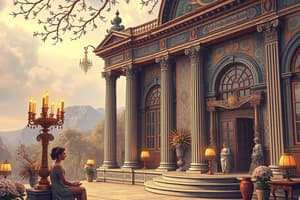Podcast
Questions and Answers
Who is known as Lord Byron?
Who is known as Lord Byron?
- Samuel Taylor Coleridge
- George Gordon Noel Byron (correct)
- Percy Bysshe Shelley
- John Keats
Where were the Elgin Marbles installed in 1819?
Where were the Elgin Marbles installed in 1819?
British Museum
What type of figurine is represented in the early Cycladic marble example?
What type of figurine is represented in the early Cycladic marble example?
Folded Arm variety
What is the name of the krater found in Mycenae known as the Warrior Vase?
What is the name of the krater found in Mycenae known as the Warrior Vase?
What is the period of the Athenian Protogeometric neckhandled amphora?
What is the period of the Athenian Protogeometric neckhandled amphora?
What is depicted in the aerial view of the Palace of Minos at Knossos?
What is depicted in the aerial view of the Palace of Minos at Knossos?
What are the materials used in the Bull's head rhyton from Knossos?
What are the materials used in the Bull's head rhyton from Knossos?
Who deciphered Linear B and when?
Who deciphered Linear B and when?
What type of vessel is the François Vase?
What type of vessel is the François Vase?
What type of artifacts were recovered from the Late Bronze Age Ulu Burun shipwreck?
What type of artifacts were recovered from the Late Bronze Age Ulu Burun shipwreck?
What type of fresco is found in Akrotiri?
What type of fresco is found in Akrotiri?
Study Notes
Lord Byron
- George Gordon Noel, 6th Baron Byron, known as Lord Byron, lived from 1788 to 1824 and was a prominent poet of the Romantic era.
- Famous for his "eastern" dress style, reflecting interests in exotic cultures and themes.
Elgin Marbles
- The Elgin Marbles were installed in 1819 in a room of the British Museum, showcasing classical Greek sculpture.
Cycladic Figurines
- The early Cycladic marble figurine of the Folded Arm variety dates back to 2700-2400/2300 BC and is part of the Dokathismata Type.
Mycenaean Warrior Vase
- A Late Helladic krater, known as the Warrior Vase, from Mycenae excavated by Heinrich Schliemann, dates to approximately 1200-1190 BC and features a pictorial style.
Athenian Protogeometric Amphora
- This amphora, from Athens and dating around 1050-900 BC, showcases mechanically drawn concentric circles and semicircles, marking an important phase in pottery.
Athenian Early Geometric Amphora
- A shoulder-handled amphora from Athens dating to approximately 900-850 BC, exemplifying the early geometric style.
Palace of Minos at Knossos
- Detailed aerial view provides insights into the architectural complexity of the Palace of Minos, a significant Bronze Age site.
West Wing of the Palace at Knossos
- The upper story of the west wing, reconstructed by Arthur Evans, features horns of consecration, symbolizing Minoan religious practices.
Minoan Scripts
- Burnt clay tablets from Minoan Crete exhibit three scripts: Minoan hieroglyphic, Linear A, and Linear B, the latter deciphered by Michael Ventris as an early form of Greek.
Bull's Head Rhyton
- The Bull's head rhyton from the Little Palace at Knossos, dating from 1550-1500 BC, is crafted from black steatite with restorations; originally featured gilded wood horns.
Snake Goddess Statuettes
- Faience statuettes from Knossos, c. 1600 BC, depict a snake goddess and her attendant, significant in understanding Minoan religion.
Sea Battle Fresco from Akrotiri
- The "Sea Battle" fresco from the West House at Akrotiri is known for its vibrant depiction of naval conflict, reflecting Minoan art and culture.
Lion's Gate at Mycenae
- The Lion's Gate, constructed between 1350 and 1200 BC, is an iconic example of Mycenaean architecture, symbolizing power and strength.
Mycenaean Linear B
- The Linear B syllabary, an early writing system of the Mycenaean Greeks, was significant in understanding Mycenaean administration and culture.
Ulu Burun Shipwreck
- The Late Bronze Age Ulu Burun shipwreck, featuring cargo like a dagger, copper ox-hide ingots, and various metals, provides evidence of maritime trade.
Michael Ventris
- Michael Ventris (1922-1956) made significant contributions by deciphering Linear B in 1952, revealing it as an early form of Greek.
Athenian Late Geometric Amphora
- The funerary amphora attributed to the Dipylon Master (c. 755-750 BC) illustrates a prothesis, an important aspect of ancient Greek burial practices.
François Vase
- The François Vase, a black-figure volute krater (c. 570-565 BC), is illustrious for its intricate scenes, including the Kalydonian boar hunt and the marriage of Peleus & Thetis.
Amasis Amphora
- This amphora by Amasis (c. 540-530 BC) depicts Dionysos surrounded by dancing maenads, showcasing the importance of religion and mythology in Athenian culture.
Exekias Amphora
- Detail from an Exekias amphora (c. 530 BC) illustrates Ajax and Achilles engaged in a game, reflecting the societal value placed on competition and leisure in ancient Greek life.
Studying That Suits You
Use AI to generate personalized quizzes and flashcards to suit your learning preferences.
Description
Test your knowledge with these flashcards from the Classics 51 course at UCLA. This quiz covers key figures, artifacts, and important events in classical history, including works by Lord Byron and other significant historical pieces. Perfect for final exam review or enhancing your understanding of classical studies.




